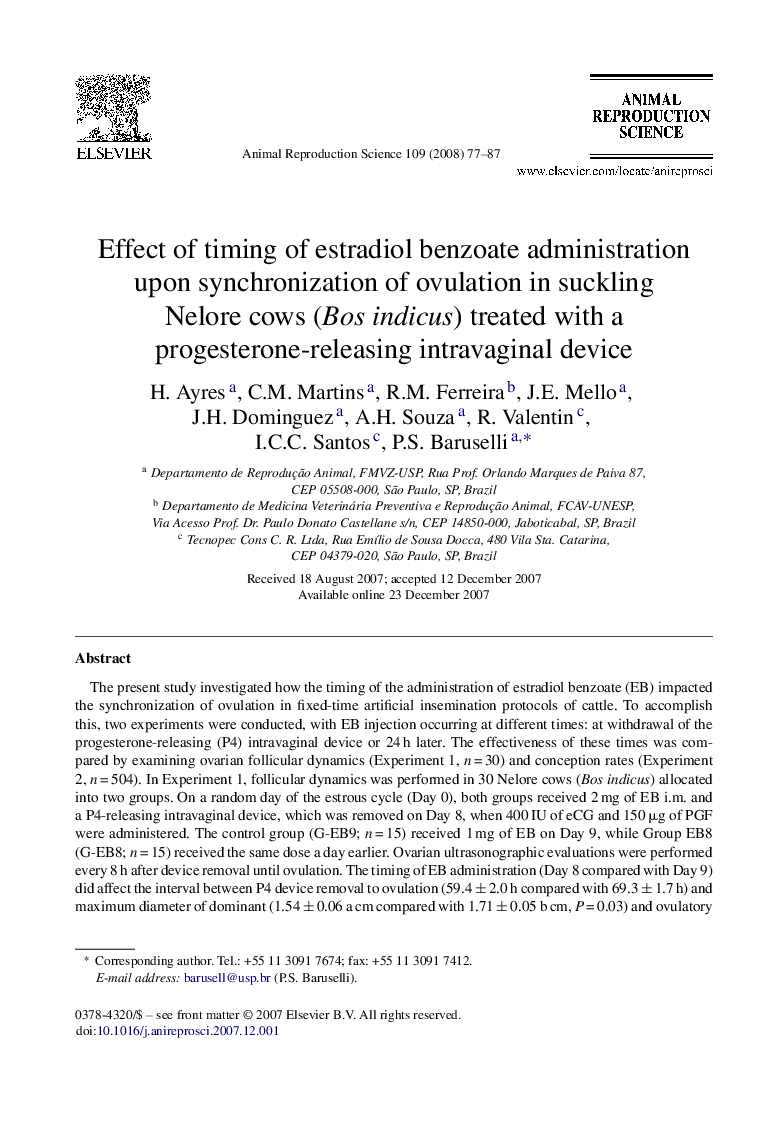| کد مقاله | کد نشریه | سال انتشار | مقاله انگلیسی | نسخه تمام متن |
|---|---|---|---|---|
| 2074366 | 1544799 | 2008 | 11 صفحه PDF | دانلود رایگان |

The present study investigated how the timing of the administration of estradiol benzoate (EB) impacted the synchronization of ovulation in fixed-time artificial insemination protocols of cattle. To accomplish this, two experiments were conducted, with EB injection occurring at different times: at withdrawal of the progesterone-releasing (P4) intravaginal device or 24 h later. The effectiveness of these times was compared by examining ovarian follicular dynamics (Experiment 1, n = 30) and conception rates (Experiment 2, n = 504). In Experiment 1, follicular dynamics was performed in 30 Nelore cows (Bos indicus) allocated into two groups. On a random day of the estrous cycle (Day 0), both groups received 2 mg of EB i.m. and a P4-releasing intravaginal device, which was removed on Day 8, when 400 IU of eCG and 150 μg of PGF were administered. The control group (G-EB9; n = 15) received 1 mg of EB on Day 9, while Group EB8 (G-EB8; n = 15) received the same dose a day earlier. Ovarian ultrasonographic evaluations were performed every 8 h after device removal until ovulation. The timing of EB administration (Day 8 compared with Day 9) did affect the interval between P4 device removal to ovulation (59.4 ± 2.0 h compared with 69.3 ± 1.7 h) and maximum diameter of dominant (1.54 ± 0.06 a cm compared with 1.71 ± 0.05 b cm, P = 0.03) and ovulatory (1.46 ± 0.05 a cm compared with 1.58 ± 0.04 b cm, P < 0.01) follicles. In Experiment 2, 504 suckling cows received the same treatment described in Experiment 1, but insemination was performed as follows: Group EB8-AI48h (G-EB8-AI48h; n = 119) and Group EB8-AI54h (G-EB8-AI54h; n = 134) received 1 mg of EB on Day 8 and FTAI was performed, respectively, 48 or 54 h after P4 device removal. Group EB9-AI48h (G-EB9-AI48h; n = 126) and Group EB9-AI54h (G-EB9-AI54h; n = 125) received the same treatments and underwent the same FTAI protocols as G-EB8-AI48h and G-EB8-AI54h, respectively; however, EB was administered on Day 9. Conception rates were greater (P < 0.05) in G-EB9-AI54h [63.2% (79/125) a], G-EB9-AI48h [58.7% (74/126) a] and G-EB8-AI48h [58.8% (70/119) a] than in G-EB8-AI54h [34.3% (46/134) b]. We concluded that when EB administration occurred at device withdrawal (D8), the interval to ovulation shortened and dominant and ovulatory follicle diameters decreased. Furthermore, when EB treatment was performed 24 h after device removal, FTAI conducted at either 48 or 54 h resulted in similar conception rates. However, EB treatment on the same day as device withdrawal resulted in a lesser conception rate when FTAI was conducted 54 h after device removal.
Journal: Animal Reproduction Science - Volume 109, Issues 1–4, December 2008, Pages 77–87